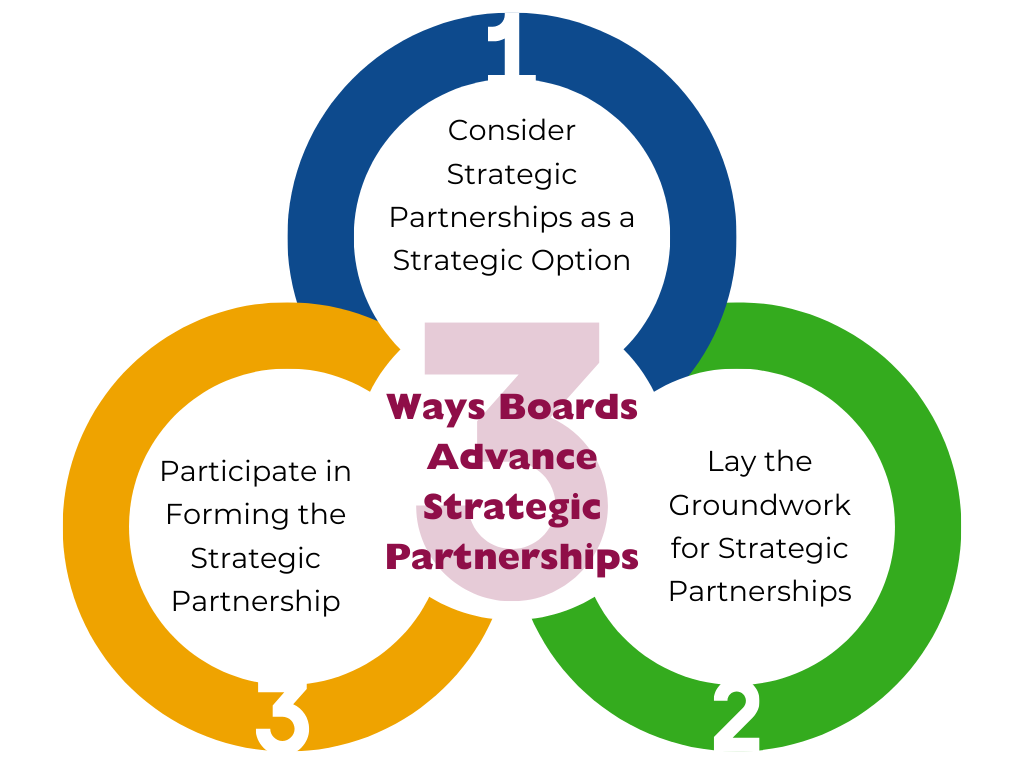Three Ways Boards Advance Strategic Partnerships

1. Considering Strategic Partnerships as a Strategic Option
One of the defining roles of a nonprofit board is to set organizational vision and strategy, and strategic partnerships is one strategy among many an organization might consider. As boards engage in strategic thinking and acting – monitoring their environment, identifying opportunities and challenges, and adjusting organizational strategy over time – it is important to examine the potential of strategic partnerships.
Whether responding to opportunities in the external environment or addressing internal business model challenges, partnership, alliance, or merger may (or may not) offer a viable and effective option. If boards don’t regularly consider how deepening partnerships may leverage organizational strengths, increase impact, advance strategic priorities, or take advantage of opportunities, then the board isn’t fully fulfilling its role as the strategic steward of the organization. Boards play a key role in having this conversation and helping organizational leaders to see strategic partnership as an advancement strategy rather than a defeat (Learn more about how strategic planning can be a catalyst for collaboration.)
2. Laying the Groundwork for Strategic Partnerships
Board members are highly valued for the relationships and networks that they can leverage on behalf of the organization. These may give them access to and insights about partnership opportunities, such as news of another organization’s executive director’s plans to retire, or lunch with the board chair of a small but promising program looking to increase its reach and impact.
Whether making key introductions or participating in initial conversations, board members can provide the spark that leads an organization to more deeply explore partnership opportunities. (This brief case study on Crittenton Women’s Union describes how boards can play lead role in identifying and pursuing partnership opportunities.)
Board members’ trusted relationship with the executive director or CEO can also be critical in laying the groundwork for strategic partnership by helping to identify when partnership could be a necessary course of action or a positive opportunity. Additionally, it can be extremely helpful for an executive staff leader to leverage their trusted relationships with board members to begin considering the possible benefits and drawbacks of a partnership. Once an organization is ready to approach a potential partner, it may be the board chair who is in the best position to approach the board chair of the other organization, as a way to open discussions. These are strategic decisions and boards should be integrated from beginning to end.
Board members may be in the best position to broach difficult conversations or tell hard truths about the organization’s need to partner in order to strengthen its work or become more sustainable; such candor is also important when identifying partnership as a strategic opportunity to leverage untapped strengths. Some board members who are more comfortable with change can play a vital role in helping fellow board members see the potential benefits of a partnership. The way things have always been done and the most comfortable position may not be what’s needed in order to stay relevant and continue delivering on an organization’s mission.
3. Participating in Forming the Collaborative Relationship
Because board members exercise legal and fiduciary responsibility for the organization and its activities, they must be involved in negotiating and approving partnerships involving any change that impacts the corporate structure, such as formation of parent-subsidiary or merger. Beyond voting to enter into good faith negotiations and then voting to move forward with merger integration, the board also has a substantial role in negotiations and determining what amount of planning must happen before to the boards are expected to vote. This negotiations phase can take many months and the process may be one of the most significant things an organization undertakes, so it’s worth slowing down to get it right and thinking deeply about how best to engage the board. Board members can help wade through the muck during negotiations. There are hundreds of details to think about in implementing a strategic partnership or merger, but board members who can see the big picture while staying focused on the end goal help to ensure the conversation moves forward.
It is the responsibility of board members, along with the staff leadership, to kick the tires and complete important due diligence, so that when a decision to move forward with partnership is made, all parties can feel confident that the unknown won’t cause challenges down the road.
However, board members bring more than just fiduciary oversight to partnership negotiations – they also bring their connection to and commitment to the organization’s mission. As ambassadors for the mission, board members can help to bring focus and purpose to partnership negotiations, in which the number one consideration must be service to the mission. Once a decision has been made to merger or form an integrated partnership, the board also has a vital role in building public support through conversations with external stakeholders and building successful relationships with board members from their partner organization. If done well, these steps can help to ensure that the mission of the organization is not only maintained, but strengthened.


Comment section
1 thought on “Three Ways Boards Advance Strategic Partnerships”